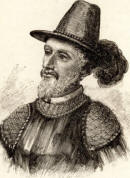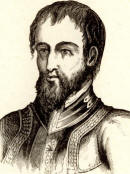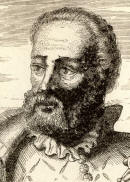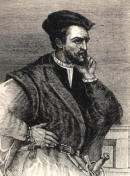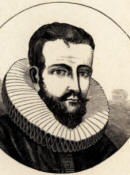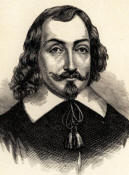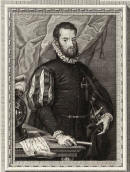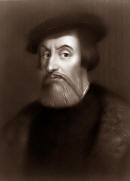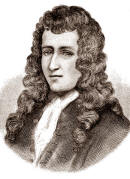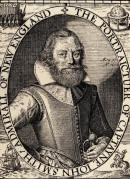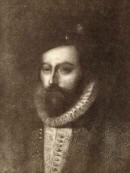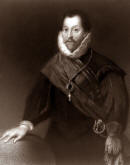Samuel de Champlain
|
|
This Site:
|
In 1815 he started on his famous expedition to the Onondaga Indians. He followed Father Le Caron and his party to Lake Huron, to which he gave the name of Mer Douce. Returning across the great forests, he sailed with several hundred canoes down a stream into the Bay of Quinte, and entered the broad Lake Ontario, which he named Lac St. Louis. With a considerable war party, chiefly Hurons, he crossed the lake into the country of the Iroquois, in (present) New York. Hiding their canoes in the forest, they pressed onward to the Indian post on the shore of Onondaga Lake. It was at the time of the maize harvest, and the Iroquois were attacked in the fields. They retired to their town, which was fortified with four rows of palisades. On the inside of these were galleries furnished with stones and other missiles, and a supply of water to extinguish a fire if kindled beneath these wooden walls. The Hurons were rather insubordinate, and the attack was ineffectual. Champlain had constructed a wooden tower, which was dragged near the palisades, and from the top of which his marksmen swept the galleries filled with naked Iroquois. But he could not control the great body of the Hurons, and, in their furious and tumultuous assault upon the palisades, they were thrown back in confusion, and could not be induced to repeat the onset, but resolved to retreat. Champlain, wounded on the leg, was compelled to acquiesce, and he made his way back to Quebec (1616), after a year's absence. The same year he went to France and organized n fur-trading company. On his return to Canada he took with him some Recollect priests to minister to the colonists and the pagans. The colony languished until 1620, when a more energetic viceroy gave it a start. Champlain got permission to fortify it, and he returned with the title and power of governor, taking with him his child-wife. Jesuit priests were sent to Canada as missionaries, and Champlain worked energetically for the cause of religion and the expansion of French dominion. In 1628 Sir David Kertk appeared with n English fleet before Quebec and demanded its surrender. Champlain's bold refusal made Kertk retire, but on his way down the St. Lawrence he captured the French supply-ships. This produced great distress in Quebec; and in July of next year Champlain was compelled to surrender to Kertk's brothers, and was carried to England. By a treaty in 1632, Canada was restored to the French. Champlain was reinstated as governor, and sailed for the St. Lawrence in 1633. He did not long survive, but worked energetically and faithfully until the last. His wife survived him. She was a Protestant when she was married, but died an Ursuline nun. Champlain's zeal for the propagation of Christianity was intense. A college was established at Quebec, in which the children of the natives were taught and trained in the habits of civilization. In 1603 Champlain published an account of his first voyage, and, in 1613 and 1619, a continuation of his narrative. In 1632 they were included in a work of his then published, which comprised a history of New France from the time of Verrazani's discoveries to 1631, entitled Les Voyages a la Nouvelle France Occidentale et Canada. He died in Quebec, Dec. 25, 1635. In 1870 a complete collection of his works, including his voyage to Mexico, with facsimiles of his maps, was published in Quebec, edited by Abbes Laverdiere and Casgrain.
|
||||||||||||||||||||||||
|
|
||
|
|
Site Copyright 2003-2018 Son of the South. For Questions or comments about this collection, contact: paul@sonofthesouth.net |
|
|
Are you Scared and Confused? Read My Snake Story, a story of hope and encouragement, to help you face your fears. |
||
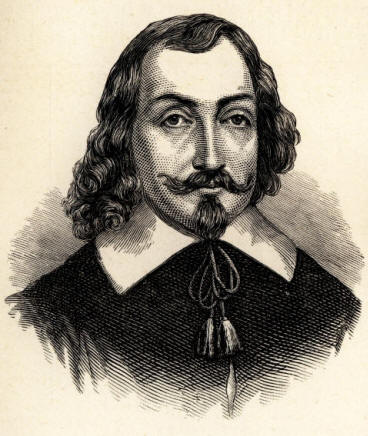 Champlain,
SAMUEL DE, French navigator; born in Brouage, France, in
1567. His family had many fishermen and mariners, and he was
carefully educated for a navigator. In early life he was in the
cavalry of Brittany, and was with his uncle, pilot-general of the
fleets of Spain, when that officer conducted back to that country
the troops who had served in France. In 1599 he commanded a vessel
of the Spanish fleet that sailed to Mexico, and he drew up a
faithful account of the voyage. On his return he received a pension
from Henry IV. of France; and he was induced by M. de Chastes,
governor of Dieppe, to explore and prepare the way for a French
colony in America. Chastes had received a charter from the King to
found settlements in New France, and the monarch commissioned
Champlain lieutenant-general of Canada. With this authority, he
sailed from Honfleur on March 5, 1603, with a single vessel,
commanded by Pont-Greve, a skilful navigator. In May they ascended
the St. Lawrence and landed near the site of
Champlain,
SAMUEL DE, French navigator; born in Brouage, France, in
1567. His family had many fishermen and mariners, and he was
carefully educated for a navigator. In early life he was in the
cavalry of Brittany, and was with his uncle, pilot-general of the
fleets of Spain, when that officer conducted back to that country
the troops who had served in France. In 1599 he commanded a vessel
of the Spanish fleet that sailed to Mexico, and he drew up a
faithful account of the voyage. On his return he received a pension
from Henry IV. of France; and he was induced by M. de Chastes,
governor of Dieppe, to explore and prepare the way for a French
colony in America. Chastes had received a charter from the King to
found settlements in New France, and the monarch commissioned
Champlain lieutenant-general of Canada. With this authority, he
sailed from Honfleur on March 5, 1603, with a single vessel,
commanded by Pont-Greve, a skilful navigator. In May they ascended
the St. Lawrence and landed near the site of
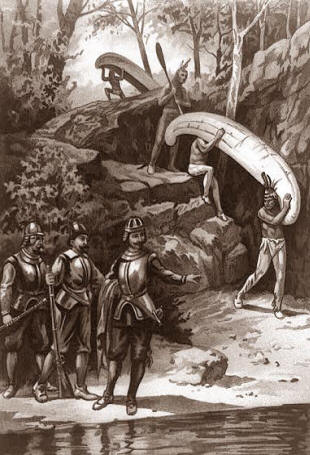 Champlain,
on his return to France in the autumn, found Chastes dead and his
concessions transferred by the King to Pierre de Gast, the
Champlain,
on his return to France in the autumn, found Chastes dead and his
concessions transferred by the King to Pierre de Gast, the
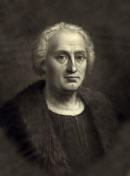
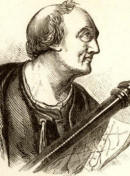
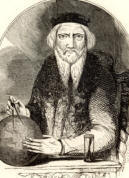
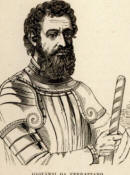
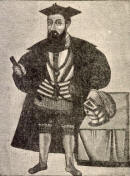
_small.jpg)
